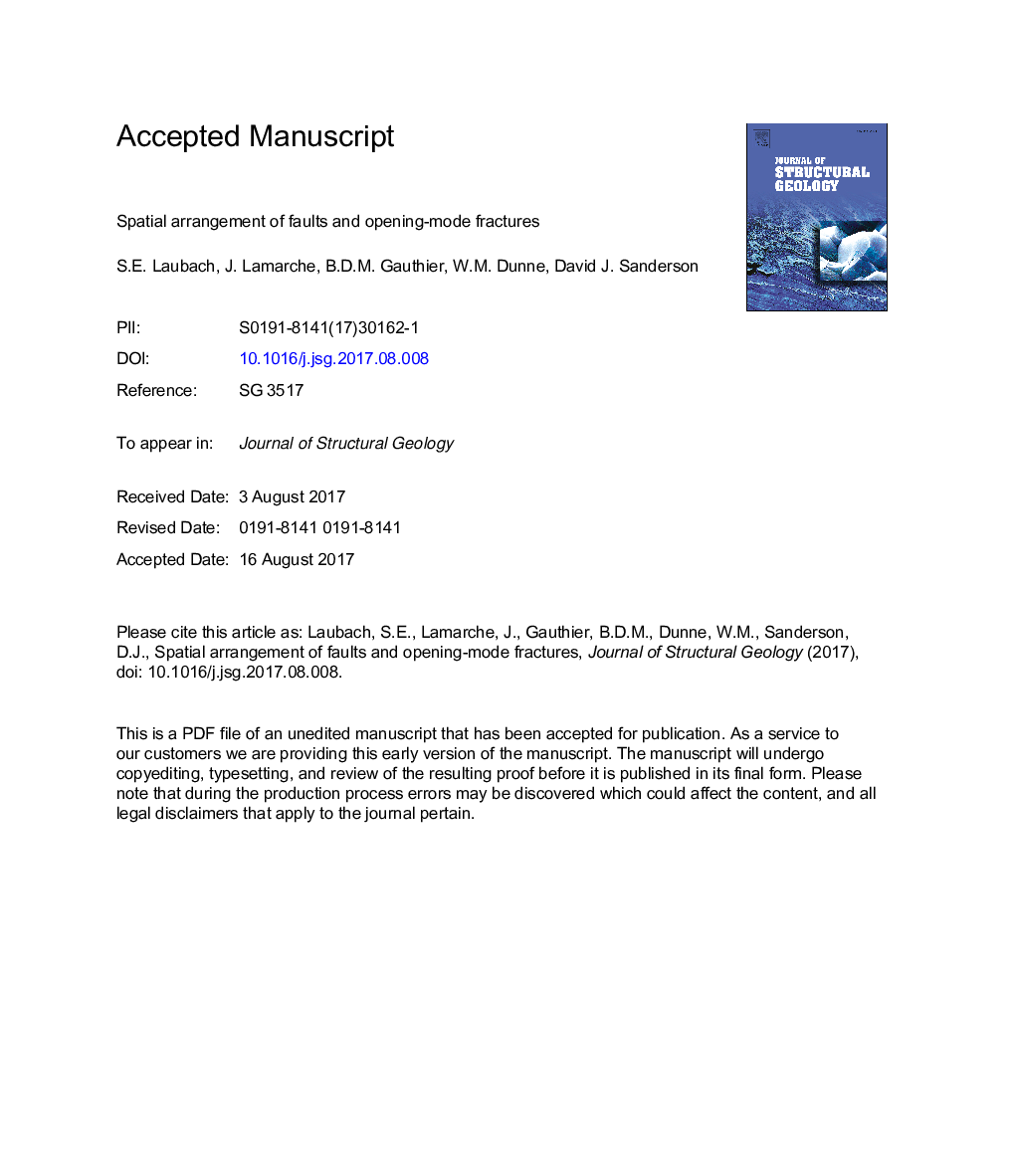| کد مقاله | کد نشریه | سال انتشار | مقاله انگلیسی | نسخه تمام متن |
|---|---|---|---|---|
| 8914467 | 1640472 | 2018 | 61 صفحه PDF | دانلود رایگان |
عنوان انگلیسی مقاله ISI
Spatial arrangement of faults and opening-mode fractures
ترجمه فارسی عنوان
ترتیب فضایی گسل ها و شکستگی باز حالت
دانلود مقاله + سفارش ترجمه
دانلود مقاله ISI انگلیسی
رایگان برای ایرانیان
کلمات کلیدی
خوشه، راهرو، فراکتال، خط مقدم، چینه شناسی مکانیکی، فاصله ازدحام، توپولوژی،
ترجمه چکیده
ترتیب فضایی یکی از ویژگی های اساسی آرایه های شکست است. الگوی خطاهای شکست و باز شدن حالت های شکستگی در فضا، ناهمگنی ساختاری و انحصاری بودن را در حجم سنگ تعیین می کند، نحوه چگونگی گسل ها و شکستگی ها بر جریان سیالات را تحت تاثیر قرار می دهد و درک ما از آغاز، انتشار و تعامل در شکل گیری الگوهای شکست را تحت تاثیر قرار می دهد. این مسئله ویژه پیشرفت های اخیر را در رابطه با مشخص کردن و درک ترتیب فضایی الگوهای گسل و شکستگی، نشان می دهد، نمونه هایی از طیف وسیعی از مقیاس ها و تنظیمات ساختاری را نشان می دهد. پنج مقالات روش های جدید و پیشرفت تکنیک های موجود را برای اندازه گیری آرایش فضایی توصیف می کنند. یکی از مطالعات، زمان تکامل روش مکانیزم شکستن باز بودن را بازنویسی می کند که اطلاعاتی است که برای مقایسه الگوهای طبیعی با رشد شکست پیشرونده در مدل های سینماتیک و مکانیکی مورد استفاده قرار می گیرد. سه مقاله بررسی نقش دیاگنیز در حال تحول در شکستگی های موضعی با چینه شناسی مکانیکی و نه بحث در مورد مکانیزم شکست شکن باز بودن. دو مقاله نشان می دهد که ارتباط مدل های خوشه ای پیچیده با مخازن غیر متعارف از طریق نمونه هایی از شکستگی ها در چاه های افقی ماسه سنگ تنگ گاز و مطالعه ی شکست شکست در شیل می باشد. چهار مقاله نشان می دهد نقش چرخش در محلی سازی شکست و الگوهای توسعه فضایی. یک مدل کاغذ در کنار اصطکاک خطا و فشار مایع و اثرات آن بر ترتیب شکستگی مربوط به خطا. مقالات مربوط به الگوهای باند تغییر شکل در سنگ های کربناته و اندازه گسل و تنظیم بیش از گسل جدایی. سه مقاله در مورد چگونگی شکستگی و شکست در حوزه های زیرزمینی و سه شکست شکست سند مورد استفاده قرار می گیرد. این مجموعه مقالات به بهبود روش های میدانی اشاره دارد، بهبود مستمر در تجزیه و تحلیل داده های کامپیوتری و ایجاد الگوهای شکست مصنوعی و فرصت های بیشتر برای شناخت ویژگی های شکست و شکست در زیر سطح از طریق تجزیه و تحلیل فضایی، اندازه و الگوی دوبعدی است.
موضوعات مرتبط
مهندسی و علوم پایه
علوم زمین و سیارات
زمین شناسی
چکیده انگلیسی
Spatial arrangement is a fundamental characteristic of fracture arrays. The pattern of fault and opening-mode fracture positions in space defines structural heterogeneity and anisotropy in a rock volume, governs how faults and fractures affect fluid flow, and impacts our understanding of the initiation, propagation and interactions during the formation of fracture patterns. This special issue highlights recent progress with respect to characterizing and understanding the spatial arrangements of fault and fracture patterns, providing examples over a wide range of scales and structural settings. Five papers describe new methods and improvements of existing techniques to quantify spatial arrangement. One study unravels the time evolution of opening-mode fracture spatial arrangement, which are data needed to compare natural patterns with progressive fracture growth in kinematic and mechanical models. Three papers investigate the role of evolving diagenesis in localizing fractures by mechanical stratigraphy and nine discuss opening-mode fracture spatial arrangement. Two papers show the relevance of complex cluster patterns to unconventional reservoirs through examples of fractures in tight gas sandstone horizontal wells, and a study of fracture arrangement in shale. Four papers demonstrate the roles of folds in fracture localization and the development spatial patterns. One paper models along-fault friction and fluid pressure and their effects on fault-related fracture arrangement. Contributions address deformation band patterns in carbonate rocks and fault size and arrangement above a detachment fault. Three papers describe fault and fracture arrangements in basement terrains, and three document fracture patterns in shale. This collection of papers points toward improvement in field methods, continuing improvements in computer-based data analysis and creation of synthetic fracture patterns, and opportunities for further understanding fault and fracture attributes in the subsurface through coupled spatial, size, and pattern analysis.
ناشر
Database: Elsevier - ScienceDirect (ساینس دایرکت)
Journal: Journal of Structural Geology - Volume 108, March 2018, Pages 2-15
Journal: Journal of Structural Geology - Volume 108, March 2018, Pages 2-15
نویسندگان
S.E. Laubach, J. Lamarche, B.D.M. Gauthier, W.M. Dunne, David J. Sanderson,
